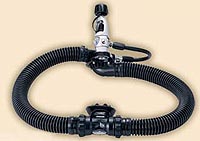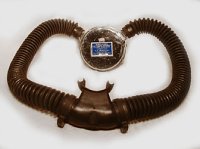« Cousteau Perfection | Main | Pool session »
April 22, 2007
That cool double-hose look
I must admit, I am really intrigued by the cool double-hose regulators seen in Cousteau documentaries and features. So when I came across a "retro" double-hose design, I was very tempted to buy it. I thought about it a lot, discussed it in detail, and then did some research. As usual, there is no definite answer. People like "retro," or else there would be no New Beetle, no resurrected Mini Cooper, no PT Cruiser, no new Ford Mustang, and no plans for reinvented Detroit muscle cars with that vintage look. There is usually a reason why designs change. Time moves on, new technologies replace older ones, and so on. But sometimes we stray too far off course and return to older designs in sort of a back-to-the-future way. Is that the case with the new old double-hose regulator I saw?
 What am I talking about here? That would be a retro regulator made by Aqua-Lung (see picture to the left). "Aqua-lung" was the name of the original diving gear designed by Emile Gagnan and Jacques Cousteau back in 1943. Somehow, today the word, also spelled "Aqualung" and "Aqua Lung," sounds sort of antiquated and the generic term "scuba" is used instead.
What am I talking about here? That would be a retro regulator made by Aqua-Lung (see picture to the left). "Aqua-lung" was the name of the original diving gear designed by Emile Gagnan and Jacques Cousteau back in 1943. Somehow, today the word, also spelled "Aqualung" and "Aqua Lung," sounds sort of antiquated and the generic term "scuba" is used instead.  The famous twin-hose Aqua-lung regulators that we generally associate with Cousteau-era diving (see picture to the right) had two corrugated air tubes, one on each side of the head. One supplied air, the other was for exhaust via a one-way valve. These diaphragm-based regulators generally had a round, tin can-like housing that contained either one, two or three stages. The mouthpiece usually had one-way valves to keep air and water from going where they shouldn't.
The famous twin-hose Aqua-lung regulators that we generally associate with Cousteau-era diving (see picture to the right) had two corrugated air tubes, one on each side of the head. One supplied air, the other was for exhaust via a one-way valve. These diaphragm-based regulators generally had a round, tin can-like housing that contained either one, two or three stages. The mouthpiece usually had one-way valves to keep air and water from going where they shouldn't.
Why the second hose? The first Aqua-lung prototypes actually only had one hose, but Cousteau found that the system began free flowing when the mouthpiece was higher than the regulator, so they fitted the second hose. That didn't completely fix the problem as air simply wants to rise, and the air in those big air hoses can pull the mouthpiece up and make it harder to breathe when the mouthpiece is lower than the regulator. The big advantage, of course, was that air bubbles emanated behind the diver's head, and not right under his nose where they interfered with photography and more easily scared fish. And without all those bubbles busting by your ears on their way up, things are quieter.
Why one, two, or three stage regulators? Well, the initial Aqua-lungs just had a single stage -- a diaphragm with a spring-loaded valve. So it was water pressure on the one side of the diaphragm and air pressure on the other. Breathing in lowered pressure and opened the valve, breathing out increased the pressure again and closed the valve before the air was vented out of holes in the can-like enclosure. It's easy to see that this arrangement only worked right at a given water pressure. Go deeper and air was wasted. Go shallower and breathing effort increased. Not so good.
So later on, Aqua-lung used 2-stage balanced designs where the first stage reduced tank pressure to an intermediate pressure of about 135 psi via a pressure-reducing valve. The second stage was a downstream diaphragm supplying air in sync with the diver's inhaling and exhaling.
As cool-looking as the two-hose design was, it had a number of disadvantages. There was the varying breathing effort depending on the position of the mouthpiece. The air-filled hoses added to buoyancy issues (though that can be minimized via hose weights). And all that air could yank the mouthpiece right out of your face when you turned into a vertical position. As a result, dual-hose designs all but disappeared around 1980. I found lots of information on old scuba equipment at www.vintagescubasupply.com and www.vintagedoublehose.com. Excellent sites, those.
Anyway, a couple of years ago, Aqua-Lung introduced a "retro" regulator, dual hoses and all. However, while it sort of looked like the originals, the new model, called "Mistral," does not have the simple elegance of the round "tin-can" dual hose regulators. With the Mistral, what you get is essentially a standard, contemporary-issue Aqua-Lung Titan first stage, largish re-breather-style hoses, and then a single-hose second stage attached to the first stage, with a small hose going from the first to the second stage. Yes, you can actually separate the second stage and put it elsewhere. The housing is new, but somehow Aqua-Lung decided not to incorporate the two stages into a cohesive unit. I've read that this was due to European regulations, though I have not seen proof of that.
How well does it work? Those who have used the new Mistral dual-hose generally seem to prefer the older, original designs such as the Phoenix Royal Aqua Master. The hoses of the retro model are described as too large and buoyant compared to the older smaller-diameter rubber hoses, though some view them, and the new mouthpiece, as an improvement. Free-flowing is still described as a problem, but users like the standard high and low pressure ports, as well as readily available service for the modern parts used in this retro Mistral. As of now, it is still on the Aqua-Lung website, but it is not listed in their 2007 catalog anymore.
So should I try to get one? There are some on eBay, and a local dive shop has one listed on its website, albeit at the very high original list price. I have no idea if I should go for it. I am tempted, though.
Posted by conradb212 at April 22, 2007 11:11 PM








